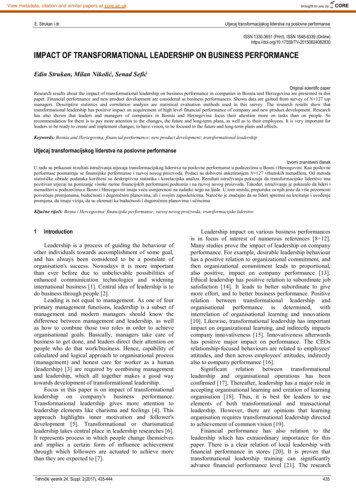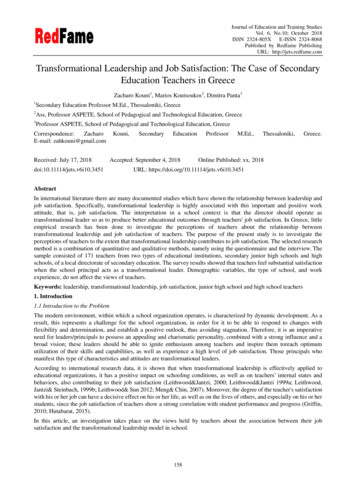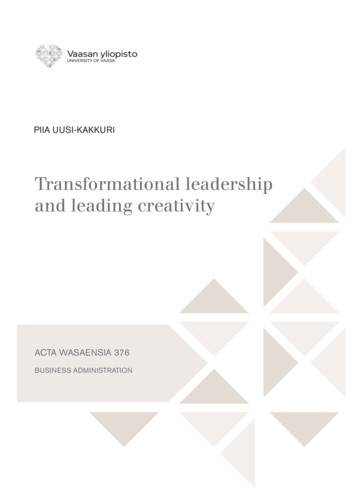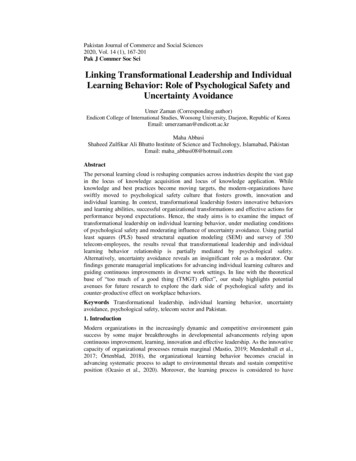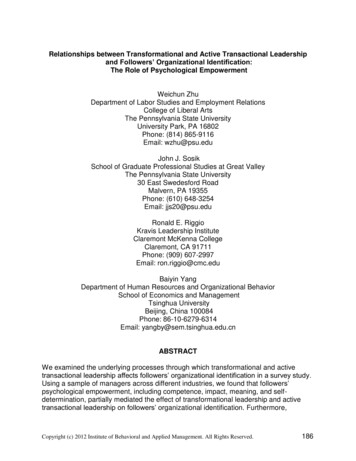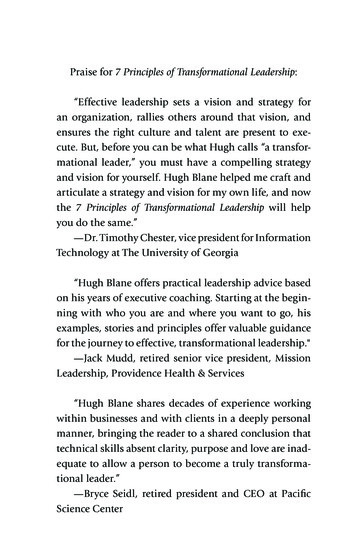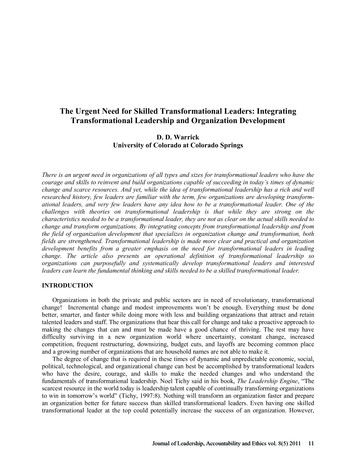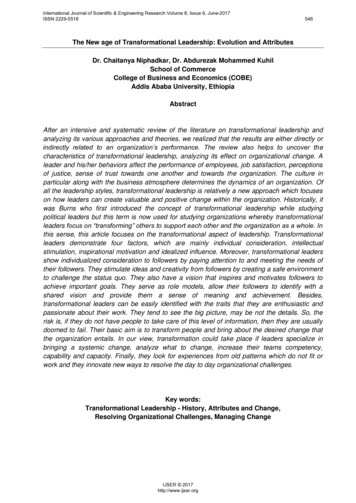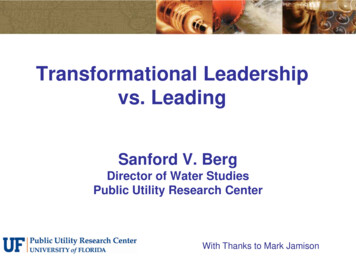
Transcription
Transformational Leadershipvs. LeadingSanford V. BergDirector of Water StudiesPublic Utility Research CenterWith Thanks to Mark Jamison
About PURC Research on energy, water, telecoms,institutions, and leadership PURC/World Bank InternationalTraining Program 148 countries, over 2500 professionals Customized and advanced courses
Online Resource Narratives summarize key topics Additional Resources: Glossary inSpanish and four other languages Frequently Asked Questions,including Social pricing to promoteaccess Management and regulation ofState-owned Enterprises 500 PDFs as References Self-paced Quizzes (for capacitybuilding and classrooms)www.regulationbodyofknowledge.org
Outline Leaders, Authorities, and Leadership Sources of Conflict and Promoting ConflictResolution Leadership in stable and changing times“Leadership in Infrastructure Policy”4www.purc.ufl.edu
ORGANIZATIONAL EFFECTIVENESS DEPENDS ONLEADERSHIPVALUESRESOURCESLEGALMANDATE
A FRAMEWORK TO PROMOTEEFFECTIVE AND EFFICIENT ATORYFRAMEWORKUTILITYOPERATIONSFRAMEWORK
LEADERSHIP PROMOTESEFFECTIVE AND EFFICIENT ERATIONS
Leadership vs. Leading Leader provides direction (when the rightdirection is already known). Leadership mobilizes people to tackledifficult and often ambiguous problemsand circumstances.(Heifetz, Ronald A. 1994. Leadership Without Easy Answers, p. 15) A node in a complex system, influencingthe system
The four sources of conflictCOGNITIVECONFLICTSBased on (technical)disagreement oninterpretation of dataINTERESTCONFLICTSAsymmetric allocation ofbenefits and costs betweenstakeholders underalternative YCONFLICTSJurisdictionaldisagreements originatingin unclear legal contextVALUESCONFLICTSInvolving ideology orpersonal preferencesregarding outcomes
Leaders Deal with Conflict1.Authority Conflicts: lack of clarity of roles2.Cognitive (Factual) Conflicts: disagreementsregarding current or historical facts and causallinkages3.Value Conflicts: conflicting priorities anddifferent weights on outcomes4.Interest Conflicts: stakeholders benefitdifferentially from decisions“Leadership in Infrastructure Policy”10www.purc.ufl.edu
Conflict ResolutionTechnicalWorkConflict OverFactsAdaptiveWorkConflict OverWhat is importantConflict OverDistribution ofGains & CostsConflict OverJurisdiction orAuthorityFrom Mark Jamison
Conflict Resolution TasksTechnicalAddressedBy Research WorkConflict OverFactsConflict OverDistribution ofGains & CostsAdaptiveWorkConflict OverWhat is importantConflict OverJurisdiction orAuthorityAddressed byEngagingPeople withAdaptiveChallengesin ResearchAnd DialogueAddressedBy ResearchAnd NegotiationFrom Mark Jamison
Authority vs. LeadershipAuthority WorkLeadership WorkProvides solutionsIdentifies challengesProtectsDiscloses threatsRestores orderExposes real conflictsMaintains normsChallenges normsFrom Heifetz, 1994
Authority vs. Leadership (1)Provides solutionsby applyingestablishedinstruments fromlaw, economics,engineering . . .etc.“Leadership in Infrastructure Policy”Identifies challengesby questioning howproblems should bedefined and pointingout why technicalsolutions cannot solveadaptive problems14www.purc.ufl.edu
Authority vs. Leadership (2)Discloses threatsby calling attention tofundamental changesin external forces thatthreaten the status quoand defy traditionalsolutions.Protectspeople and the“system” fromexternal threats.Stability has value.“Leadership in Infrastructure Policy”15www.purc.ufl.edu
Authority vs. Leadership (3)Restores orderso that work cancontinue wheninternal or externalforces disrupt thenormalperformance ofwork.“Leadership in Infrastructure Policy”Exposes real conflictsor facilitates theiremergence so that thoseinvolved face and workthrough tough choices.16www.purc.ufl.edu
Authority vs. Leadership (4)Maintains normsso that people canwork by followingestablished rulesand proceduresand not waste time“reinventing thewheel.“Leadership in Infrastructure Policy”Challenges norms toensure that “solutions”are not adopted beforethe new environmentis fully understood, thereal conflicts areresolved, and keytrade-offs are made.17www.purc.ufl.edu
Answers or Questions? We tend to look to experts and leadersfor answers But it is more important to ask the rightquestions than to get correct answersto wrong (or irrelevant) questions. Leadership involves creating anorganizational culture that honors thequestions and those who ask them“Leadership in Infrastructure Policy”18www.purc.ufl.edu
Performance ImprovementNot: “What is the right policy (tactic) orstrategy?”Rather: “How do we constantly change andadapt without losing the things that aremost important?”Short Term: Adapt to realityLong Term: Modify constraintsUltimate goal: Improve Utility Performance“Leadership in Infrastructure Policy”19www.purc.ufl.edu
Reset for Leadership Develop fresh perspectives andknowledge about the future, all the whileholding in trust the wisdom of the past Qualities that help: Charisma: inspirationalAuthenticity: honestyCommunication: accessible listenerConflict Recognition/Resolution“Leadership in Infrastructure Policy”20www.purc.ufl.edu
The four sources of conflictCOGNITIVECONFLICTSBased on (technical)disagreement oninterpretation of dataINTERESTCONFLICTSAsymmetric allocation ofbenefits and costs betweenstakeholders underalternative YCONFLICTSJurisdictionaldisagreements originatingin unclear legal contextVALUESCONFLICTSInvolving ideology orpersonal preferencesregarding outcomes
Choice when Context ChangesDecisions when there is a novel experienceIgnore it: hope it is an illegitimate or temporarychallengeRecognize it for what it is and either Adaptive Behavior: Learn the new reality andadaptAvoidance Behavior: Leave the future to othersLive in dysfunction (government option)“Leadership in Infrastructure Policy”22www.purc.ufl.edu
Tools for LeadershipBenchmarking: You manage what youmeasure.High Quality Staff: People matterStakeholder Engagement: Understand allperspectivesManage Expectations: Unrealistic goalslead to disappointment and anger.“Leadership in Infrastructure Policy”23www.purc.ufl.edu
Benchmarking Statistical benchmarking can reduceinformation asymmetries. Regulatoryagencies can share information to makecomparisons across comparable firms. For incentive purposes, the bestcomparisons are on some overalldimension. The publication of overall performancecomparisons can put pressure on poorlyperforming divisions (yardstickcomparisons)
High Quality Staff High quality staff need to be rewardedif they are to be retained. Without highly motivated technicalstaff, the studies analyzing alternativepolicies will be inadequate. Planning and Operations both requiretechnical skills and teamwork.“Leadership in Infrastructure Policy”25www.purc.ufl.edu
Engage with StakeholdersStakeholder Relationships are important,so getting the company’s intentions,objectives, and policies clearly laid outby the press becomes a significantagency activity.Find forums that promote awarenessHeadlines sell newspapers so theeducation of journalists and the generalpublic warrants substantial attention.“Leadership in Infrastructure Policy”26www.purc.ufl.edu
Manage Expectations Only make promises you can keep The best technical studies andinnovative incentive schemes will notbe accepted if their rationales cannotbe communicated to major stakeholdergroups. Those with narrow interests need to bebrought into the decision-process earlyon so that their perspectives can beheard and taken into account“Leadership in Infrastructure Policy”27www.purc.ufl.edu
Adaptive Learning28 Investigate the novel experience to learn newrealities (changing beliefs) and to adapt rulesand strategies Yet is difficult to “unlearn” something youbelieve. Effects Lowers ambiguity, which improvesproductivity Requires conscious effort and consumesmental resources Inspiration: Potential to increase “profits”by improving beliefs
Technical vs. AdaptiveChallengesWhat’s thework?Who Doesthe Work?TechnicalApply currentknow-howAuthoritiesAdaptiveLearn newwaysThe people withthe problemFrom Heifetz and Linsky, 2002
Getting on the Balcony
Observing from the Balcony
Create a Holding EnvironmentSafety Stress
ResetIn some contexts, change is important. Thechange might be to go where others havegone before, but it might be onto new ground.“Reset” means developing fresh perspectivesand knowledge about the future, trusting thewisdom of the past. Focus on Next practices, not Best practices. Focus on Why rather than on What Focus on Leadership not on Leading(Jamison and Castañeda, 2009)
Next practices, not Bestpractices Best practice is about imitation (followingin someone else’s footsteps). A focus onnext practice is needed when we are goinginto areas where no one has gone before.Heifetz, Grashow, and Linsky. 2009. “Leadership in a (Permanent)Crisis.” Harvard Business Review
Why rather than What When we ask ourselves “What should we donext?” we emphasize practice. But the practiceneeds a foundation, basic principles, and values. Ask “Why have certain practices or why haveexperiments been successful or unsuccessful?” sothat we analyze our underlying priorities and ourcontext. We learn, keep what is important, anddiscard what holds us back.Collins, 2009. How the Mighty Fall and Why Some CompaniesNever Give in
Do we need Institutional changes? Structural problem Training/education? Personal skill problems Patience?“Leadership in Infrastructure Policy”36www.purc.ufl.edu
Conclusion“The good leader is he who the peoplerevere. The great leader is he whothe people say, ‘We did it ourselves.’”Lao-Tzu
Leadership. vs. Leading Leader provides direction (when the right direction is already known). Leadership mobilizes people to tackle difficult and often ambiguous problems and circumstances. (Heifetz, Ronald A. 1994. Leadership Without Easy Answers, p. 15) A node in a complex system, influencing the system
